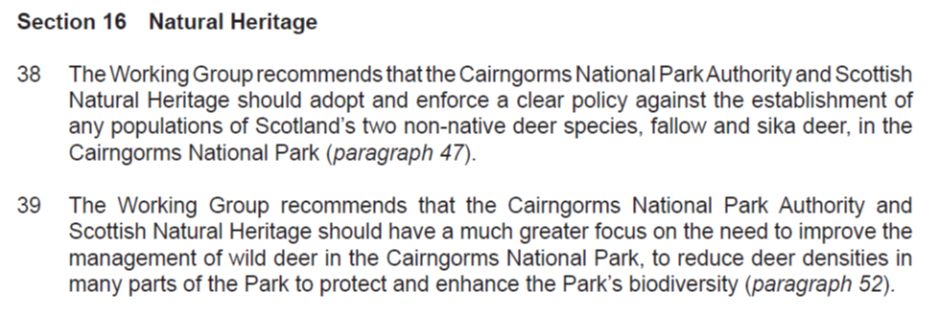
My apologies for accidentally omitting the final three paras from Dave Morris’ post on Balmoral and the recommendations of the Deer Working Group.They have been added to the post and posted for convenience below.
In the section of the Deer Working Report that addresses the impact of deer on the Natural Heritage there is an excellent section (see here for extract) on National Parks, albeit almost entirely focussed on the Cairngorms. This is very measured and comes to the conclusion that both National Park Authorities could and should be doing more. Hence the two recommendations quoted above.
Underpinning the thinking of the DWG is:
“a clear expectation that standards of land management should be higher in National Parks than in the wider countryside because of their special status”
This is absolutely right and a complete contrast to the Werrity Report that completely avoided the question of what our National Park Authorities might be doing to address the issues associated with destructive grouse moor management in their areas.(see here)
Missing paragraphs from the end of Dave Morris’s post on Deer and Balmoral
“A last-resort power to reduce deer numbers to protect the natural heritage is found in section 8 of the Deer (Scotland) Act 1996. It enables SNH to carry out a cull and to re-coup the costs through sale of the venison and charging the landowners with the remainder of the costs. Such a “control scheme” has never been used, presumably because of potential adverse reactions from landowners. The alternative, as indicated above, is “control agreements” set up by SNH under section 7 of the Act. This requires voluntary cooperation by the landowners. But the Caenlochan situation demonstrates that such agreements can go on year after year, involving endless negotiation between SNH and landowners, without any significant habitat improvement, even when these habitats are of international significance. The need to apply a section 8 control scheme to Balmoral and the other 5 estates who lead the South Grampian DMG is obvious.. If the Scottish Government is serious about the climate change emergency and accepts that land use changes are needed now to meet this challenge, it should apply a section 8 control scheme in the Caenlochan area without delay.
Looking further ahead it is evident that a new framework for deer management is needed. That will require the Scottish Parliament to legislate for a Deer (Scotland) Act to replace the previous Acts of 1959 and 1996 as passed by the UK Parliament. The new Act must remove the right of landowners to determine the population levels of all species of deer, recognising that deer are a community resource, not a private possession subject to exploitation. The right to determine the population level of each deer species must be transferred to a local community, regional or national government body so that a publicly accountable organisation determines how many deer are to live within each DMG area..
Meanwhile the Royal Family have been telling the world in recent months how to repair the earth’s life support systems. Excellent, they are doing a good job from Davos to Africa to Pakistan. Now they need to sit down in the nearest castle or palace, read the DWG report, and take the necessary action on Balmoral. While setting this example they also need to provide the essential leadership which is required to persuade their fellow estates in the Cairngorms National Park that overgrazing and degradation of natural forest and montane habitats is totally unacceptable in a time of climate emergency. Regenerating our uplands is an absolute priority to capture carbon, safeguard biodiversity and reduce downstream river flooding. It will also be the perfect legacy for Simon Pepper, who did more than anyone to solve Scotland’s “deer problem”.”